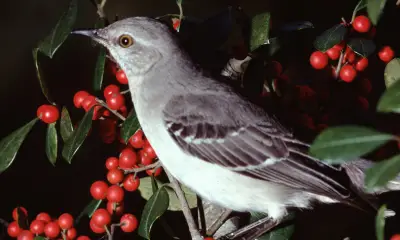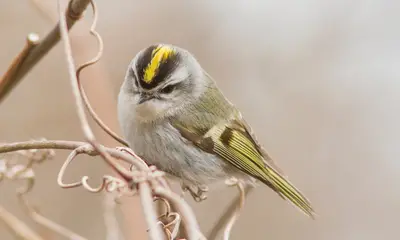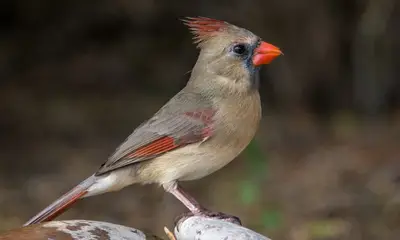15 Types Of Hawks With STRIPED TAILS (ID Guide With Photos)
Did you recently come across a hawk with striped tail feathers, and want to know what species it was?
Identifying hawks with banded tails is not as easy as it might seem, since there are many raptors in North America that fit this description.
To help you identify the bird you saw, we’ll cover the most common hawks with striped tails in North America in this article.
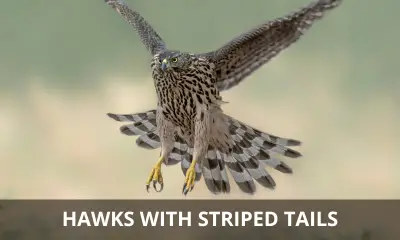
What types of hawks have striped tails?
There are 15 types of hawks in North America that have stripes on their tails, and these are described in full detail below.
Let’s dive into the details, and take a closer look at each of these stripe-tailed hawks:
Red-shouldered Hawk
Scientific name: Buteo lineatus

The Red-shouldered Hawk is a small buteo species that can be readily identified by its rufous red shoulder patch, as well as its striking black and white striped tail.
The Red-shouldered Hawk has two distinct populations – one in the eastern US, and another in California and Mexico. These two populations are separated by more than 1000 miles, and rarely mix.
This raptor is found in lowland forests throughout its range, where it favors mature woods interspersed with water.
While the northernmost populations of Red-shouldered Hawks are migratory, southern populations are non-migratory, with adult birds staying in their nesting territories all year round.
Swainson’s Hawk
Scientific name: Buteo swainsoni
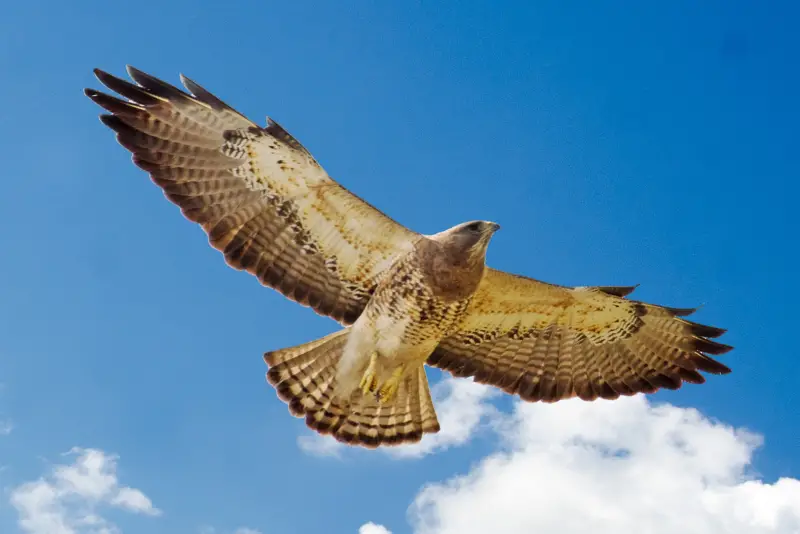
The Swainson’s Hawk is a compact buteo species that frequents dry prairies and open areas in western North America.
They have long, narrow wings, and are best identified by their brown chest, which contrasts with the white belly of these hawks.
Another distinguishing feature of Swainson’s hawks are their banded tail feathers. The thickest and darkest band is located at the distal edge of the tail, while more proximal bands gradually become thinner and fainter.
In fall, these birds gather in flocks numbering in the tens of thousands that migrate south together, often together with other birds of prey, such as Broad-winged Hawks.
They are summer visitors throughout the western half of North America, where they can be seen from April through September.
Swainson’s Hawks are strictly migratory birds that spend the winter in Argentina.
Broad-winged Hawk
Scientific name: Buteo platypterus
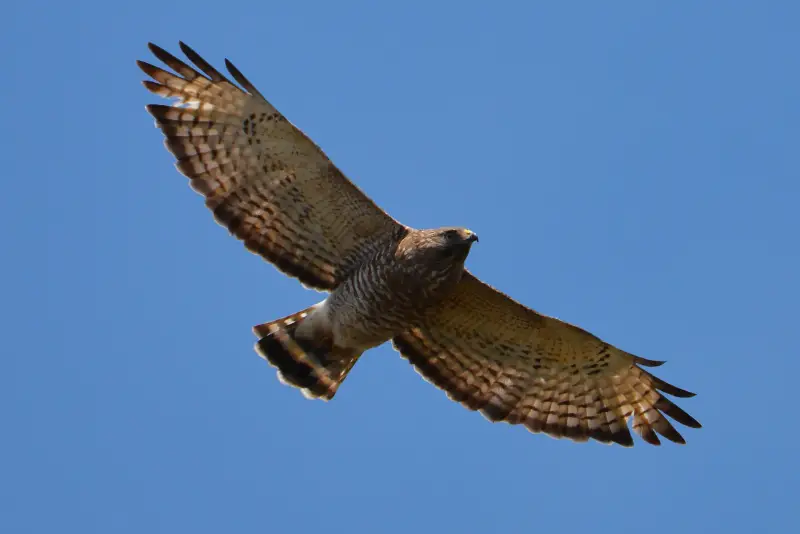
The Broad-winged Hawk is a long distance migratory species that spends the winter in South America.
They can be identified by their broad wings, which are slightly shorter than the wings of most other buteo species.
Another great feature to identify these raptors are their barred tails, with two thick brown stripes alternating with two white stripes.
During fall migration, it’s not uncommon to see flocks (also known as “kettles”) of Broad-winged Hawks soaring together to take advantage of thermal currents on their way south.
The Broad-winged Hawk is a widespread but uncommon breeding bird throughout the eastern half of North America.
The preferred habitats of these medium-sized raptors are extended forests, where the best way to detect them is by listening to their whistling call.
White-tailed Hawk
Scientific name: Geranoaetus albicaudatus

White-tailed Hawks are easily recognizable by their distinct markings, which include a white underside, a white tail with a dark brown band at its end, and a dark brown upperside.
In the United States, these raptors are only found in southern Texas, where they occur in the coastal prairies close to the Mexican border.
They predominantly feed on lizards and small snakes, as well as insects and rodents.
Similar to kestrels, they like to hunt by “kiting,” which involves using the wind to hover in a fixed position, as they wait for prey to appear on the ground below.
Rough-legged Hawk
Scientific name: Buteo lagopus

The Rough-legged Hawk is a breeding bird of the arctic tundra in northern Canada and Alaska, but can be seen wintering in large parts of the USA during the cold months.
This is a large buteo that is best identified by its dark brown belly, which contrasts with the white underside of its wings and tail, as well as a broad dark brown stripe at the end of its tail.
It can be seen in the United States from October through March, and favors open habitats such as farmland, pastures and marshland.
Its preferred foraging tactic is to hunt from a perch, such as a fence post or telephone pole, though it also hovers on occasion, similar to a kestrel.
Gray Hawk
Scientific name: Buteo plagiatus
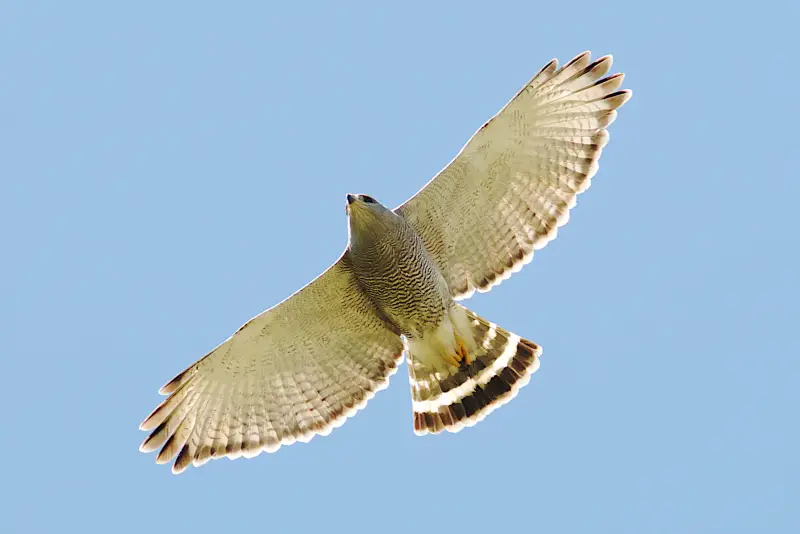
The Gray Hawk is a Central American buteo species that also breeds in a few areas of Texas and Arizona just north of the Mexican border.
It is almost entirely light gray, with light barring on its underside, as well as black and white striped tail feathers.
This elegant raptor most often hunts from a perch in trees along a river or stream.
It patiently waits for reptiles and small mammals on the ground, which it catches by dropping down on them from its perch.
Zone-tailed Hawk
Scientific name: Buteo albonotatus
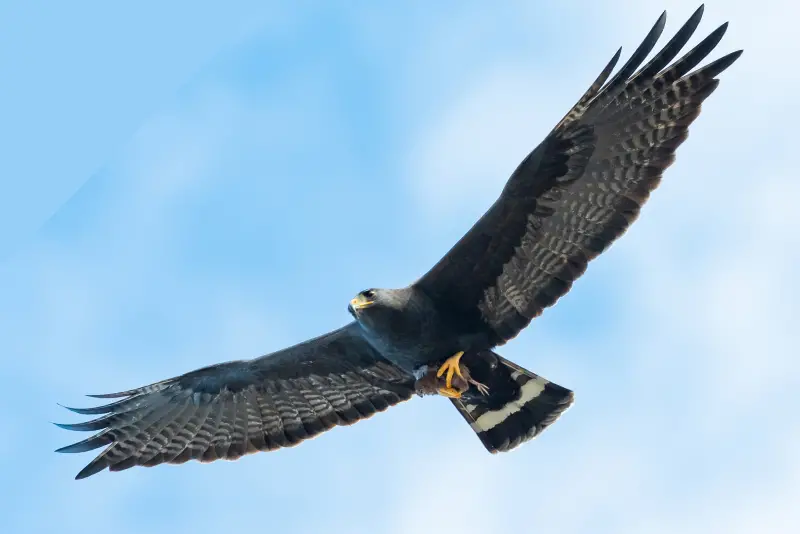
The Zone-tailed Hawk is another migratory hawk species found in the southern United States during the breeding season in summer.
These hawks are black and white, with an entirely black body contrasting with a bright white band on their tail, as well as white patches on the flight feathers.
Interestingly, these raptors resemble Turkey Vultures both in their overall appearance and in their behavior.
Ornithologists believe that this similarity is not an accident, and that Zone-tailed Hawks use it to their advantage, as most of their prey species see Turkey Vultures as harmless.
They favor arid cliffs, canyons and foothills, where they hunt small mammals, reptiles and birds.
Harris’s Hawk
Scientific name: Parabuteo unicinctus

This is a large buteo hawk with a long tail and long legs. It is a black raptor with chestnut patches on its shoulders, as well as on its thighs.
Another great distinguishing feature of the Harris’s Hawk is the white terminal band at the end of the tail, which is clearly visible when it soars on thermal currents.
These Hawks are most commonly found in Mexico and South America, but also breed in a handful of southern states, including Texas and Arizona.
Unlike most raptor species, the Harris’s Hawk is very social, and often hunts in groups of 3 or more individuals.
Scientists have found that cooperatively hunting birds are more successful than those that hunt alone.
Common Black Hawk
Scientific name: Buteogallus anthracinus
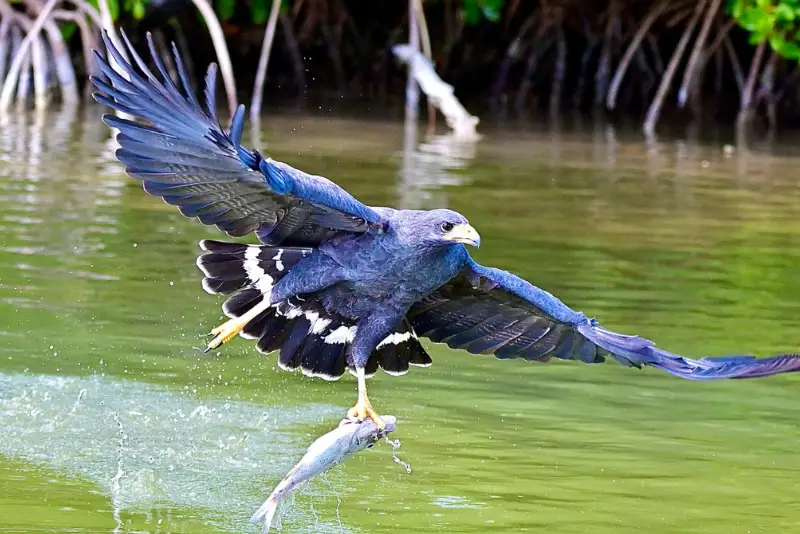
This is a large hawk with broad wings and a relatively short tail. It is best identified by its soot black color which contrasts with a single white band on its tail.
Common Black Hawks are most commonly found in Mexico and Central America, but also have a breeding population in Arizona.
They frequent canyons with wooded streams, where they primarily hunt fish, amphibians, and rodents that live in and around water.
These raptors migrate south in September, to spend the winter in Mexico. In Central America, they are most often found in swamps and marshy areas.
Sharp-Shinned Hawk
Scientific name: Accipiter striatus
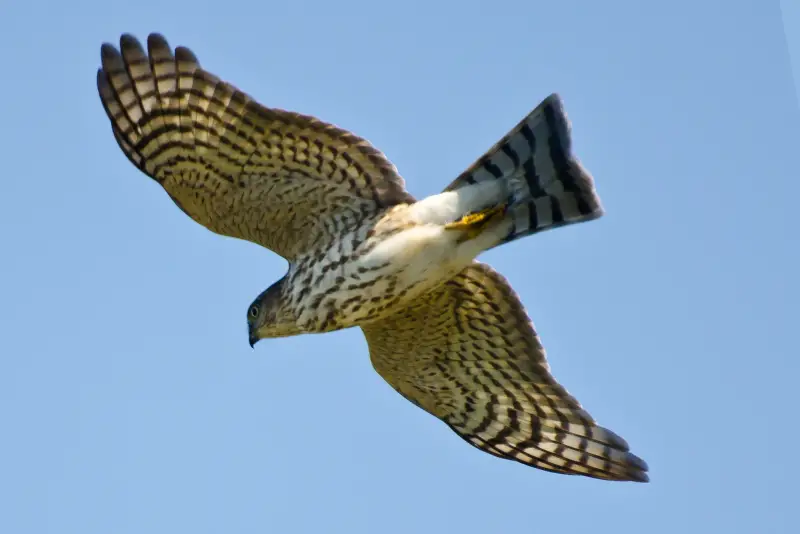
The sharp-shinned hawk is the smallest accipiter species in North America, and is most commonly seen stalking song birds, making it a regular sight in backyards.
These hawks are recognizable by their small size, agility, and long tail with dark stripes. The striped tail is most obvious in juvenile birds, but is also present in adult birds.
They breed in coniferous and mixed forest across northern North America, and spend the winter in the southern United States and Central America.
Cooper’s Hawk
Scientific name: Accipiter cooperii
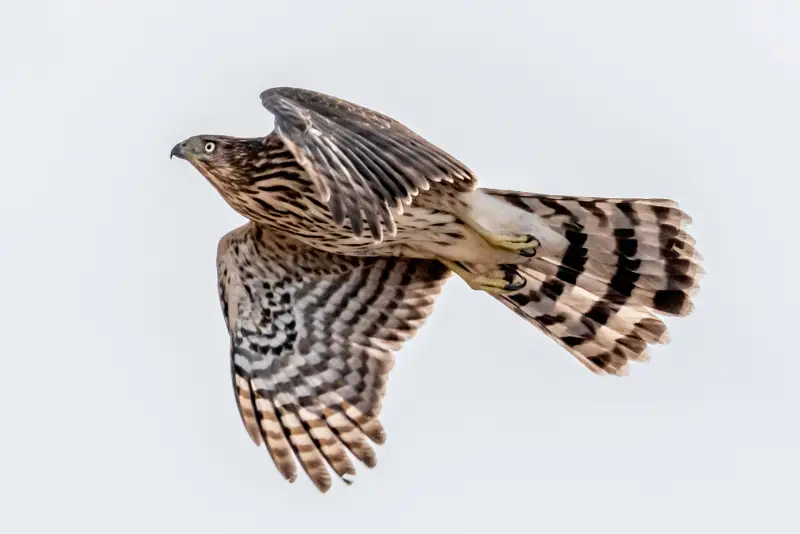
While Cooper’s Hawks were originally shy woodland raptors, they are now commonly found in urban areas across North America, where they hunt pigeons and songbirds.
This little bird of prey is highly agile when it comes to catching small to medium-sized birds in flight. Sometimes it will even take species that are larger than itself.
The long striped tail of the Cooper’s Hawk is more rounded at the edges than that of the Sharp-shinned Hawk, which is one of the best features for distinguishing these two similar species.
It is not unusual for a Cooper’s Hawk to show up at a bird feeder, where it tries to surprise and ambush feeding songbirds with a lightning fast dash from a hidden perch.
It is a summer visitor in the northern parts of North America, while it can be found year-round in southern states.
Northern Goshawk
Scientific name: Accipiter gentilis
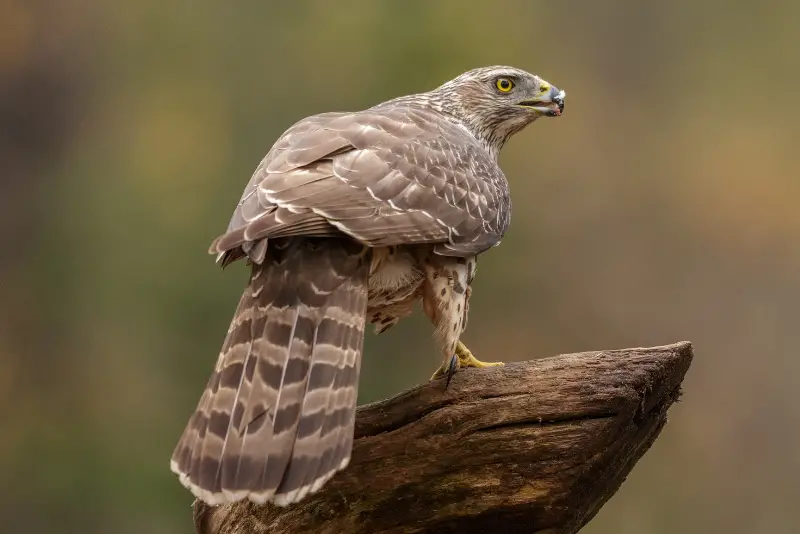
The Northern Goshawk is the largest accipiter species in North America, and significantly larger than the Coopers’ and Sharp-shinned Hawks.
It also has slightly longer wings and a barred tail with rounded edges, and as a result looks slightly similar to buteo species.
However, its behavior is very different from buteos, as it spends much less time soaring or perched in prominent locations.
Instead, the Northern Goshawk hunts by flying at low altitude over open woodland or along forest edges, in order to surprise its prey out in the open.
When this raptor does hunt from a perch, it is usually well hidden, and thus hard to spot.
Northern Harrier
Scientific name: Circus hudsonius
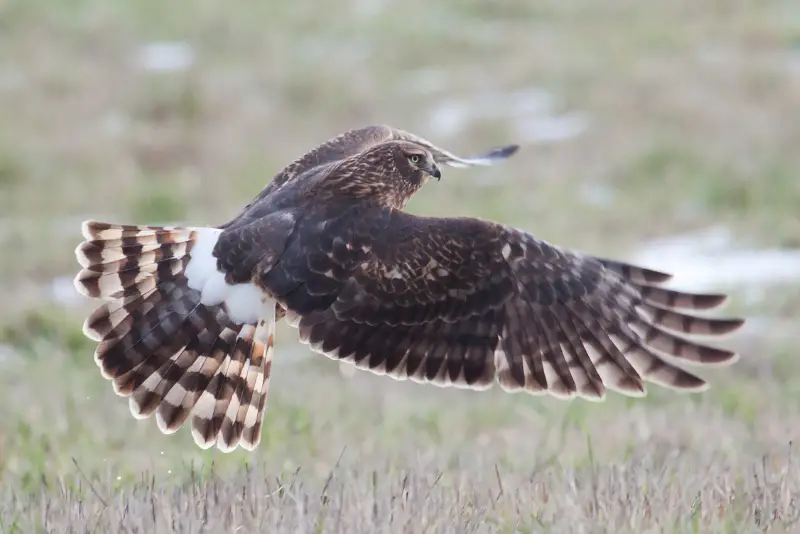
The Northern Harrier is a breeding bird of the northern parts of North America, but spends the winter in the southern USA and Central America.
Adult male Northern Harriers have a light grayish-blue upperside, as well as a white underside that contrasts with their black wing tips.
Females are largely dark brown, with clear stripes on their tails, as well as a broad white band at the base of the top of the tail, which is only visible from above.
This harrier is a winter bird in many parts of the United States from October through April, where it frequents open grassland and marshes.
Harriers are most easily identified by their behavior. Their foraging tactic is to fly slowly just a few feet above the ground, in order to pounce on any rodent caught outside its burrow.
Osprey
Scientific name: Pandion haliaetus
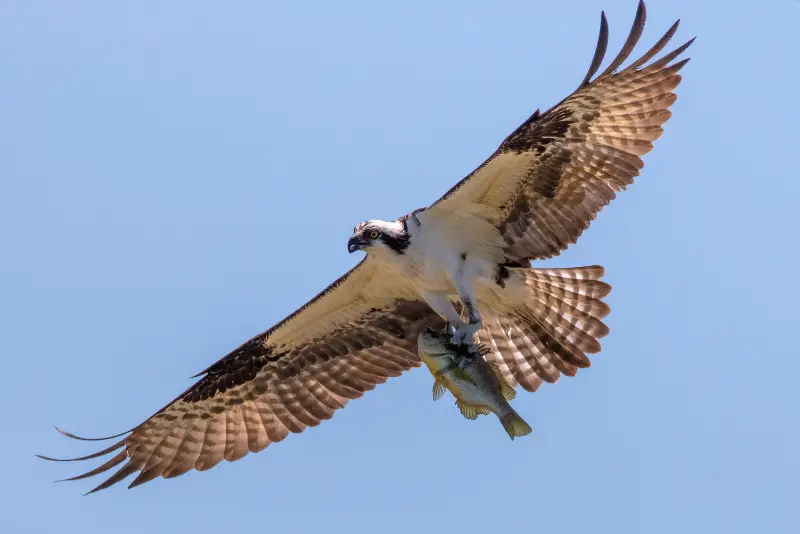
While the Osprey is technically not a hawk, it resembles a very large hawk with a wingspan of up to 69 in (5.5 ft).
It is usually easy to identify the Osprey due to its striking white belly, white chest, and barred tail, which contrast with its blackish gray upperparts.
This large North America bird is the only raptor species that plunges into water in order to catch fish, often becoming entirely submerged in the water as it attempts to grab a fish with its feet.
Due to this style of hunting, Ospreys are almost always found close to water, except during migration, when they will cross areas without water.
The Osprey is a widespread though rare breeding bird throughout northern North America, and also occurs as a winter bird in southern parts of North America.
Final remarks
In summary, here are the 15 types of hawks that have stripes on their tails:
- Red-shouldered Hawk
- Swainson’s Hawk
- Broad-winged Hawk
- White-tailed Hawk
- Rough-legged Hawk
- Gray Hawk
- Zone-tailed Hawk
- Harris’s Hawk
- Common Black Hawk
- Sharp-shinned Hawk
- Cooper’s Hawk
- Northern Goshawk
- Northern Harrier
- Osprey
If you’ve spotted one of these raptors while bird watching, but aren’t sure which species it was, check our detailed identification guide with photos above.
And if you enjoyed this article, check out our guide to the hawks of Texas.

